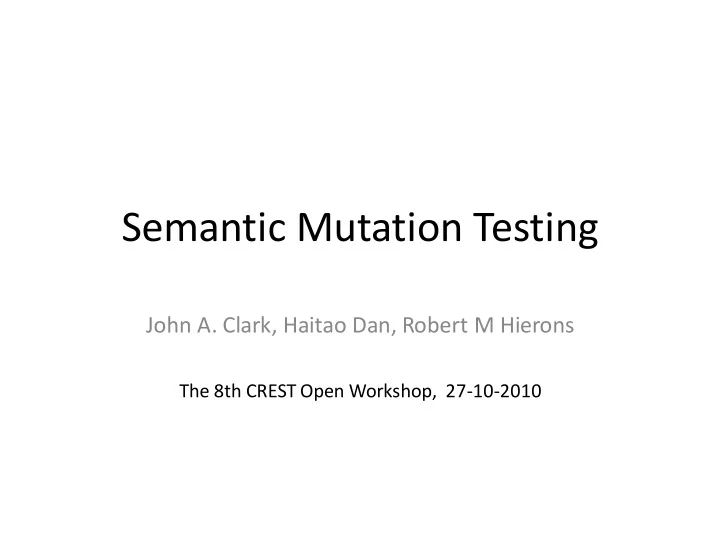

Semantic Mutation Testing John A. Clark, Haitao Dan, Robert M Hierons The 8th CREST Open Workshop, 27-10-2010
An example: cruise control
Question • What happens in no_vehicle_in_front if brake and level=increase?
Another question • What happens in no_vehicle_in_front if a vehicle is detected and level=increase?
The problem • Traditional mutation operators introduce changes similar to ‘slips’. • Sometimes a developer/user will make semantic mistakes: – They will misunderstand the semantics of part of the language they are using
Semantic Mutation • A developer has been using language X with semantics L and moves to X with semantics L’. • How do we find test data to find resultant faults?
An alternative: switching between programming languages • Developer moves between two languages at the same level of abstraction that have different semantics for a common construct. • Example: – Logical connectives in C and Ada. • C uses short-circuit evaluation; • Ada has alternatives (with and without short-circuit evaluation)
Scenario: refinement/retrenchment • Similar constructs can have different semantics. • Examples: – integer division in Z and Ada – retrenching infinite types (issues with precision, bounds on the types)
A simple framework • We have a syntactic entity N in a language with semantics L. • Traditional mutation operators transform (N,L) to some (N’,L) • Semantic mutation operators transform (N,L) to some (N,L’) *or maybe even (N’,L’)+ • They aim to find a different type of mistake.
Current status and future work • Prototype tool being developed for C • Some experiments being conducted to explore nature of semantic mutants: – How many are produced? – How do they relate to traditional syntactic mutants? – What are good operators? – Are there many trivial or equivalent mutants? • More experiments
A Semantic Mutation Tool for C
GUI of SMT-C*
GUI of Test Runner* • Running results of test suites and testcases: statistics and the result for each test suite and testcase with graphical highlight; • Progress bar; • Test error traces.
Mutant generation* Mutant generation -- support three different scopes
Tool Architecture
Implementation Overview • The tool is developed using Java and as Eclipse plug-ins. • It also can be published as an independent testing tool based on Rich Client Platform (RCP) of Eclipse. • For current version, TXL is used to drive the semantic mutation and Check is used to support mutant compilation and running tests.
TXL – as a prototyping mutation engine • It is a generalized source-to-source translation system. • It takes as input an piece of source code, and a set of transformation. • It produces as output the transformed source code. • Example: – txl source1.c tranform_rule.txl
Semantic Mutation Operators • Thirteen semantic mutation operators have been implemented. – ASD, MFC_R, FTA_F… • 6 traditional mutation operators were also implemented for conducting experiments to compare traditional and semantic mutation operators. – SCRB, SSWM, SSDL …
CHECK • A unit testing framework for C. • Check is based on Autotools. • Many advanced features: run in fork mode (allow signal and early exit), test fixture, multiple suites in one runner, looping tests, test timeouts, determining test coverage, xml logging etc.
Future work of SMT-C • Implement more semantic mutation operators. • Improve the GUI, better integration with C development process. • Enhance mutant generation function: mutant management, function scope mutation and efficiency. • Accelerate the mutation generation and testing processes.
?
Recommend
More recommend